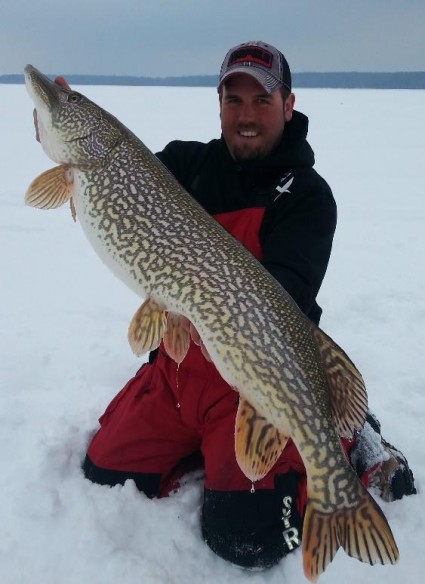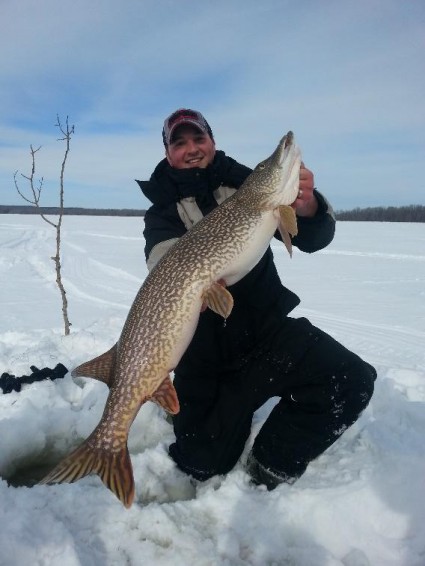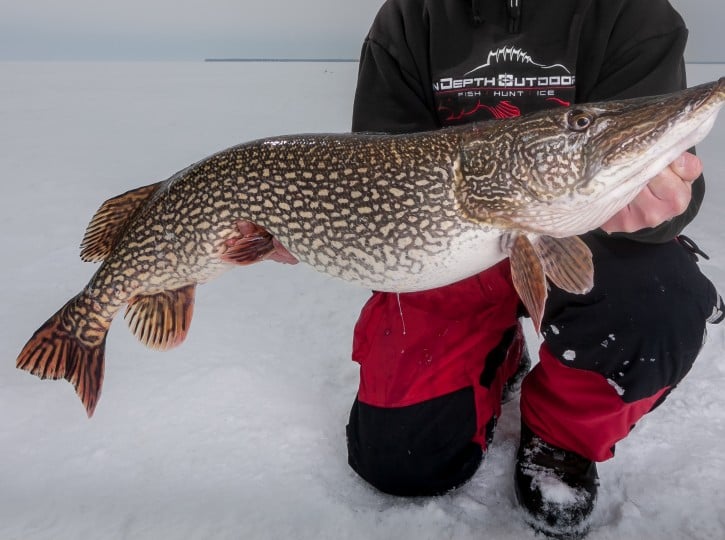Ice fishing for Northern Pike is not rocket science. For the most part it is fairly simple to locate and catch these carnivores, as they are one of the most aggressive predators lurking beneath the frozen surface. It seems that nearly every body of water in the state of Wisconsin has an abundance of these toothy creatures. What I would like to share with you are ways to eliminate catching little “hammer handles”, “snakes”, “snot rockets” and/or whatever other names you want to call the abundant, but smaller Pike. We are looking for the elite class of trophy fish in the upper 30 to mid 40 inch range. Here is a quick breakdown of where and how I will start my search and approach these bad boys.
 First of all you can’t catch big fish if big fish don’t inhabit the body of water you are fishing. This goes for all other species of fish as well. This is when the work begins. Wisconsin has roughly 15,000 lakes, let’s say 25% of them have potential for producing trophy size fish; that means there are still 3,750 lakes to try. I’m always game for giving it the old college try, but I do not have a money tree growing in my backyard, nor do I have 100 days a winter for the next 40 years to give my old college effort on lakes that “might” be good. Here are a few things that I do to put the odds in my favor. One is word of mouth. If you know someone who caught the right caliber of Pike recently, find out what body of water, or area it was caught. Often you will hear of anglers that catch, or see some really big Pike while fishing for panfish or other gamefish. Another great way to find the right body of water for this is to use the Lake Finder on the Wisconsin DNR’s website. This goes for other states as well, providing you can access the right information. Most of the lakes that you will find have had some sort of survey in the past ten years. These surveys will give you an idea of the size, structure and numbers of fish that live in that particular body of water. Generally lakes that overall have a lower number of Pike have bigger ones. Find the lakes that have those 30+ inch fish, not loads of mid 20’s. The next thing you want to look at is the forage base. I prefer lakes that contain Smelt, Cisco, Tullibee, or a Shad base. Big, greasy forage allows these girls to get big in a hurry. Next, you want to look for larger bodies of water that offer deep water access. Try to pick a lake that is at least 1,000 acres. This increases your odds of catching a multitude of giants.
First of all you can’t catch big fish if big fish don’t inhabit the body of water you are fishing. This goes for all other species of fish as well. This is when the work begins. Wisconsin has roughly 15,000 lakes, let’s say 25% of them have potential for producing trophy size fish; that means there are still 3,750 lakes to try. I’m always game for giving it the old college try, but I do not have a money tree growing in my backyard, nor do I have 100 days a winter for the next 40 years to give my old college effort on lakes that “might” be good. Here are a few things that I do to put the odds in my favor. One is word of mouth. If you know someone who caught the right caliber of Pike recently, find out what body of water, or area it was caught. Often you will hear of anglers that catch, or see some really big Pike while fishing for panfish or other gamefish. Another great way to find the right body of water for this is to use the Lake Finder on the Wisconsin DNR’s website. This goes for other states as well, providing you can access the right information. Most of the lakes that you will find have had some sort of survey in the past ten years. These surveys will give you an idea of the size, structure and numbers of fish that live in that particular body of water. Generally lakes that overall have a lower number of Pike have bigger ones. Find the lakes that have those 30+ inch fish, not loads of mid 20’s. The next thing you want to look at is the forage base. I prefer lakes that contain Smelt, Cisco, Tullibee, or a Shad base. Big, greasy forage allows these girls to get big in a hurry. Next, you want to look for larger bodies of water that offer deep water access. Try to pick a lake that is at least 1,000 acres. This increases your odds of catching a multitude of giants.
Now that we have our lake of choice it is time to pick a location. For the most part, I will not fish any deeper than the 10’ or 12’ mark throughout the hard water season. Concentrating on shallow water insures that you will be sitting over fish that are in a feeding mood. Early in the season I will concentrate my efforts in the backs of bays. Those with weeds and wood in them are the ones that will hold most of the fish. If you can find large, shallow flats with 1-3 feet of water on them, you’re are in luck. As the season progresses Pike will start to move towards deeper water. This is when I shift my focus to setting up on main lake points, with deep water access. You are looking for the ones that top out really shallow (less than 5’), and are at the mouths of your early season feeding bays. Every lake is a little different and some of these points may have weeds, wood, rock or sand. Any of those choices are good as long as there is deep water nearby. Pike will ambush baitfish off the edges of these points. I will concentrate on the outer 1/3 of them, and stagger my lines from the shallowest spot out to about 10’-12’. As we near the end of the ice fishing season, Pike will start to move ultra-shallow again as they get ready to spawn. The spawn happens on most lakes during ice out or just after. Therefore this is your best chance at that giant you have been looking for. Location at this time of year is in the back ends of bays, or at the mouth of any creek inlet. I can’t stress enough how you cannot go too shallow. Having only a foot of water underneath the ice is plenty of room for these Pike to roam around.
 We have our lake, and location, now it is time to impart a few basic techniques to use and bring them topside. For most anglers, tip up fishing is going to be the greatest mean of success. They are easy to use, and allow you to cover water. There are many different tip ups on the market, and for the most part they all work great. I like to use the Frabill Pro-Thermal because they stack in a bucket nicely and insulate your hole to eliminate freezing. My main line consists of 50 yards of 30# Suffix Tip-Up Line. To this I attach 3’ of 20# Suffix Invisiline Flourocarbon leader material. On the leader I will run a split shot with a #6 VMC Treble Hook or a Northland Tackle Quick Strike Predator Rig, depending on what I am using for bait. Whenever I use mid-sized golden shiners or suckers I will use the #6 treble hook. When I start using super-sized bait, as well as smelt, late in the season I will then use the Predator Rig. This rig consists of a multi hook system on a leader for fishing big bait. When you set the depth on your tip up keep in mind that Pike always look up, so you want to keep your offering high in the water column. In most cases this means anywhere from 3 feet off the bottom to just under the ice, depending on water clarity.
We have our lake, and location, now it is time to impart a few basic techniques to use and bring them topside. For most anglers, tip up fishing is going to be the greatest mean of success. They are easy to use, and allow you to cover water. There are many different tip ups on the market, and for the most part they all work great. I like to use the Frabill Pro-Thermal because they stack in a bucket nicely and insulate your hole to eliminate freezing. My main line consists of 50 yards of 30# Suffix Tip-Up Line. To this I attach 3’ of 20# Suffix Invisiline Flourocarbon leader material. On the leader I will run a split shot with a #6 VMC Treble Hook or a Northland Tackle Quick Strike Predator Rig, depending on what I am using for bait. Whenever I use mid-sized golden shiners or suckers I will use the #6 treble hook. When I start using super-sized bait, as well as smelt, late in the season I will then use the Predator Rig. This rig consists of a multi hook system on a leader for fishing big bait. When you set the depth on your tip up keep in mind that Pike always look up, so you want to keep your offering high in the water column. In most cases this means anywhere from 3 feet off the bottom to just under the ice, depending on water clarity.
Now you are ready to hit the ice. The last important part of getting these beast’s topside is having a hole in the ice large enough to fit them through. I prefer to use a Strikemaster Lazer power auger in a 10”. The 10” will make life a lot easier when you are eye to eye with a four footer. After staggering your holes across your spot it is time to set lines and wait. Be patient as most days you may only get one or two chances at hooking up, but I think you will be pleasantly surprised when you see what is waiting on the other end of the line.
-Adam Rasmussen

Hi Adam,
Nice pike! I’m a little surprised that your able to get away with 20# test for the leader. I’ve had the occasional bite off with 20# and use 60#. But whatever your doing it looks like it’s working.
Cheers,
JOC